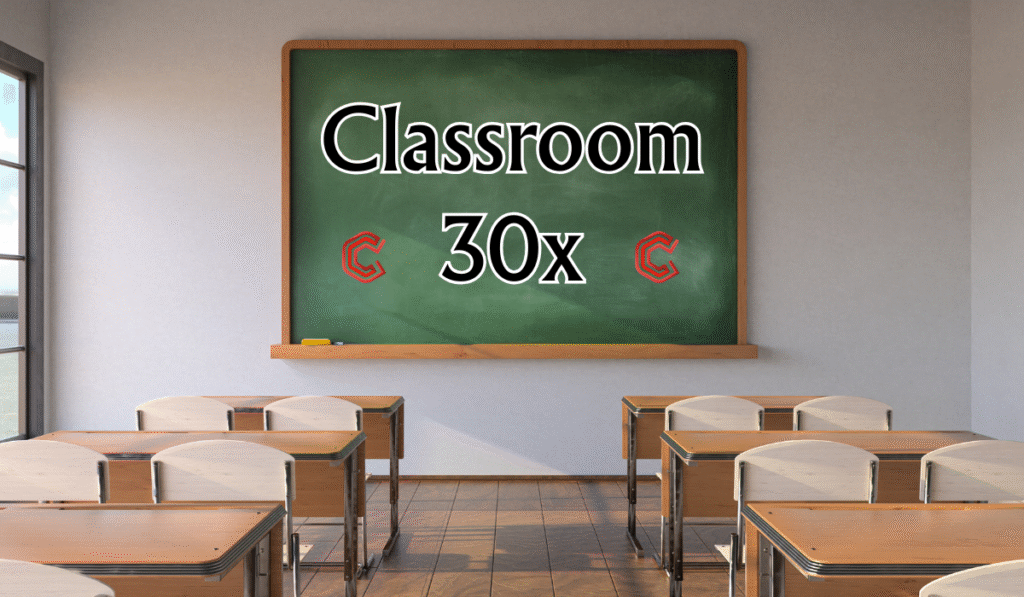In a rapidly changing educational landscape, the traditional classroom is undergoing a major transformation. Welcome to the era of Classroom 30x — a futuristic approach to education that fuses technology, pedagogy, and physical space to create the ultimate learning ecosystem. This is not merely an upgrade of digital tools or rearrangement of desks. It is a complete redesign of how we teach, learn, and interact within an academic setting.
Classroom 30x represents more than a trend — it’s a vision. And that vision is already shaping the future of education.
Understanding the Concept of Classroom 30x
So what exactly is classroom 30x? Unlike traditional labels such as “smart classroom” or “virtual classroom,” Classroom 30x is a holistic and forward-thinking framework that integrates next-gen technologies, adaptive environments, and human-centered design.
The “30x” in Classroom 30x
The “30x” signifies exponential advancement. Just as Moore’s Law predicted the doubling of computer processing power every two years, Classroom 30x symbolizes the exponential growth of educational capabilities when innovation is multiplied — not linearly, but exponentially.
This concept goes beyond one-to-one device programs or the inclusion of interactive whiteboards. It suggests that by upgrading 30 critical elements of the educational experience — from physical layout and air quality to machine learning algorithms and emotional AI — we can transform the classroom into a dynamic engine of intellectual and personal growth.
The 7 Pillars of Classroom 30x
To understand classroom 30x in full, we need to break it down into its foundational pillars. Each one plays a critical role in redefining the learning space.
1. Personalized AI-Driven Learning
At the core of Classroom 30x is artificial intelligence. Unlike one-size-fits-all education models, AI-driven personalization adjusts content based on student behavior, pace, preferences, and even emotional states. Systems powered by natural language processing and machine learning create feedback loops that optimize learning for every individual.
- AI tutors that adapt in real-time
- Intelligent grading systems
- Emotional recognition to gauge mental readiness
These innovations are not hypothetical — they’re already being tested in pilot programs globally.
2. Hybrid Infrastructure: Physical + Digital + Spatial
Classroom 30x blends virtual reality, augmented reality, and physical learning environments into a seamless experience.
- VR field trips to ancient Rome
- AR-enhanced textbooks
- Modular furniture with embedded sensors
It’s not about replacing the physical classroom but enhancing it with immersive layers of data and experience.
3. Biophilic and Responsive Design
Nature is a powerful teacher. Biophilic design elements — such as living walls, natural lighting, and organic materials — are integrated into Classroom 30x environments to enhance cognition and reduce stress.
Additionally, rooms respond to their occupants. Sensors detect temperature, CO2 levels, noise, and adjust accordingly to ensure optimal learning conditions.
4. Neuroadaptive Interfaces
Neuroadaptive technology uses brain-computer interfaces (BCIs) to monitor cognitive load, attention span, and engagement.
- EEG headbands that suggest when to take a break
- Eye-tracking software for real-time comprehension analysis
While still in experimental stages, these interfaces will soon be a key part of the Classroom 30x toolkit.
5. Decentralized Knowledge Hubs
Knowledge is no longer centralized. Blockchain technology enables students to own their credentials, assignments, and records. Micro-credentials and modular certifications give students autonomy over their learning paths.
In Classroom 30x, learning isn’t confined to grade levels or school hours — it’s on-demand and borderless.
6. Teacher 3.0
Teachers in Classroom 30x are facilitators, mentors, and technologists. Rather than lecturing for hours, they curate digital resources, moderate Socratic dialogue, and offer one-on-one AI-assisted coaching. They are trained in instructional design, emotional intelligence, and data analysis.
Professional development evolves into continuous improvement, powered by analytics dashboards and peer feedback systems.
7. Community-Centric Ecosystems
Classroom 30x is not isolated from the community. Local industries, global experts, parents, and mentors become stakeholders in the learning journey. Students collaborate with real-world practitioners, bridging the gap between classroom and career.
Live video labs, virtual internships, and crowdsourced innovation challenges form part of the real-world learning scaffold.
Case Studies: Classroom 30x in Action
Case Study 1: Singapore’s AI-Powered Secondary Schools
Singapore is pioneering Classroom 30x concepts through its national EdTech strategy. Select schools are deploying AI systems that track learning outcomes and tailor content to individual student needs. Real-time dashboards allow educators to intervene early, reducing dropout rates and improving academic performance.
Case Study 2: Finland’s Modular, Nature-Based Learning Spaces
Finland’s education system has adopted biophilic design principles alongside modular classrooms that adapt based on lesson needs. Classrooms transition between group collaboration, solo work, and kinesthetic learning — all monitored by environmental sensors.
Case Study 3: The California MetaLearning Project
Partnering with tech firms, schools in California have piloted classrooms equipped with AR-enhanced learning materials, BCI headbands, and gamified learning ecosystems. Students can visualize atomic structures in 3D or explore mathematical models in virtual environments.
These examples underscore that Classroom 30x is not a hypothetical vision — it’s an evolving reality.
Classroom 30x vs. Traditional Classrooms: A Comparative View
| Feature | Traditional Classroom | Classroom 30x |
|---|---|---|
| Teaching Model | Lecture-based | Personalized, AI-driven |
| Technology Use | Minimal, often static | Immersive, adaptive, dynamic |
| Physical Design | Fixed seating, standard lighting | Modular, biophilic, responsive |
| Data Analytics | End-of-term evaluations | Real-time feedback and learning analytics |
| Learning Speed | One-size-fits-all | Self-paced and adaptive |
| Student Role | Passive recipient | Active participant and co-creator |
| Assessment | Standardized tests | Competency-based, real-time micro-assessments |
| Teacher Role | Instructor | Facilitator and mentor |
The Future Roadmap of Classroom 30x
The Next 5 Years
- Widespread adoption of AI tutors in public schools
- Learning spaces designed using virtual simulations before construction
- Expansion of blockchain-verified student portfolios
The Next 10 Years
- Fully neuroadaptive classrooms using EEG and biometric interfaces
- Global collaborative classrooms across time zones
- AI mentors capable of simulating philosophical debates or technical mentorship
The Long-Term Vision
By 2040, Classroom 30x could become the global standard. Education will no longer be constrained by geography, economic disparity, or outdated curriculum models. Instead, it will be defined by creativity, customization, and collaboration.
Myths and Misconceptions About Classroom 30x
“Technology will replace teachers.”
Not true. Classroom 30x enhances the human role in education. Technology enables teachers to spend more time mentoring, less time grading.
“Only rich schools can afford Classroom 30x.”
In reality, much of the technology used in Classroom 30x is open-source or becoming increasingly affordable. Cloud-based tools and mobile-first platforms lower the cost of implementation.
“Students will become too reliant on screens.”
Classroom 30x emphasizes balance — blending screen time with real-world experiences, outdoor learning, and peer collaboration.
Implementing Classroom 30x: Steps for Schools
If you’re an educator or policymaker ready to embrace this transformation, here are practical steps:
- Start Small: Begin with AI-powered learning platforms or smart desks.
- Invest in Teacher Training: Equip educators with knowledge in EdTech and design thinking.
- Redesign Spaces: Create multipurpose zones within existing classrooms.
- Gather Data: Use learning analytics to inform pedagogical choices.
- Partner with Innovators: Work with EdTech startups, researchers, and architects.
Why Classroom 30x Matters Now More Than Ever
The world is changing at breakneck speed. Jobs are being automated, economies are globalizing, and knowledge is doubling at exponential rates. To keep up, students need more than rote memorization — they need agility, empathy, collaboration, and critical thinking.
Classroom 30x is not about teaching kids to use gadgets. It’s about equipping them to thrive in a world that doesn’t yet exist.
In a way, the classroom becomes less of a room and more of an engine — constantly adapting, learning, and evolving alongside its occupants.
Conclusion: The Promise of Classroom 30x
We stand at the edge of a new frontier in education. The path ahead is not without challenges — equity, privacy, data ethics, and access will require thoughtful solutions. But the promise is immense.
Classroom 30x is not just the future of education; it is its redefinition. It invites us to think exponentially, build inclusively, and learn relentlessly. As we navigate this transformation, the classrooms of tomorrow will not just teach — they will listen, adapt, and evolve.
Let us build classrooms not for the past, but for the possible.


